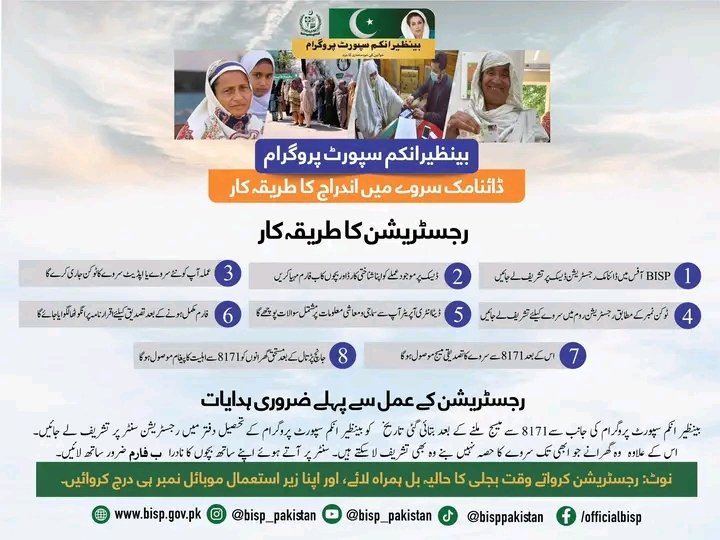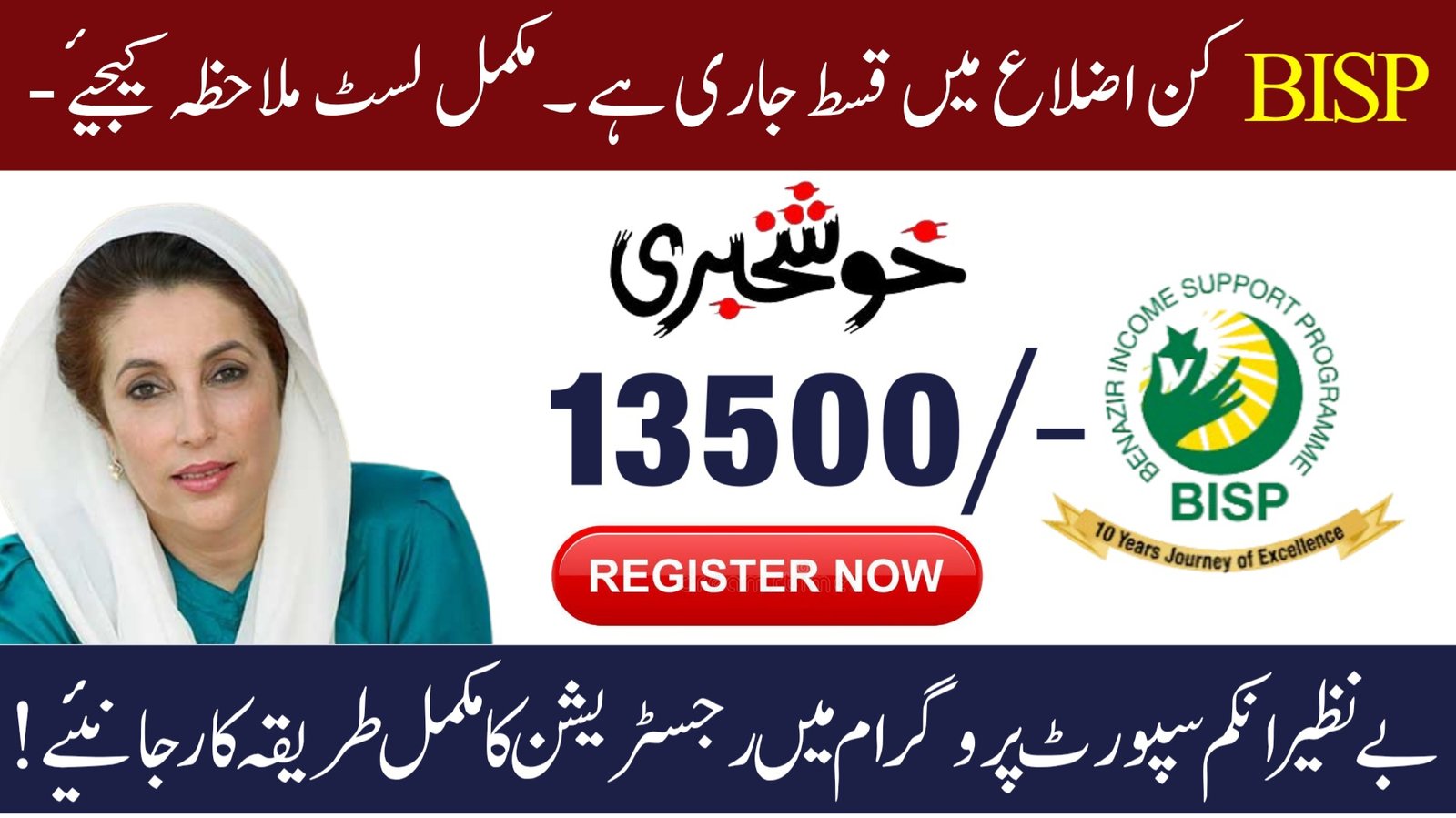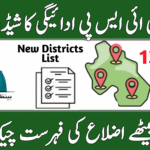The Benazir Income Support Program (BISP) has expanded its coverage in 2025 by including new districts for the BISP Rs 13,500 scheme. This expansion allows more low-income families to receive quarterly financial support, helping them cover household expenses, healthcare, and education costs. Families in newly included areas should check their BISP eligibility to take advantage of this assistance.
Important Facts About BISP Rs 13,500
| Feature | Details |
|---|---|
| Stipend Amount | Rs 13,500 per quarter |
| Payment Frequency | Four times a year |
| Eligibility | Poorest households based on Poverty Scorecard |
| CNIC Requirement | Valid CNIC for all adult members |
| Proof of Residence | Utility bill, lease, or municipal receipt |
| Newly Added Districts | KPK, Balochistan, Punjab, Sindh, Gilgit Baltistan |
| Application | Local BISP registration centers |
| Benefits | Financial support, healthcare, education, and social protection |
The inclusion of new districts for BISP Rs 13,500 in 2025 reflects the government’s goal to include more deserving households under the BISP 2025 eligibility criteria. Families in remote or previously excluded areas now have a real opportunity to access BISP financial assistance.
Prominent List of Newly Added Districts
The government has added new districts for BISP Rs 13,500, making it easier for families in underdeveloped regions to apply. The new districts are:
Khyber Pakhtunkhwa (KPK):
- Lower Kohistan
- Kolai Palas
- Shangla subdivisions
Balochistan:
- Washuk
- Chaghi subdivisions
Gilgit Baltistan:
- Ghanche subdivisions
Sindh:
- Sujawal subdivisions
Punjab:
- Talagang region
- Jampur subdivisions
Families living in these new districts added for BISP 2025 should check their BISP eligibility online at bisp.8171.gov.pk using their CNIC.
How to Check Your BISP Eligibility
To verify if your area is included in the new districts for BISP Rs 13,500, follow these steps:
- Visit bisp.8171.gov.pk
- Enter your CNIC number
- Select your union council, tehsil, and district
- Check the status of BISP eligibility
Tips for verification:
- Carry proof of residence such as utility bills or municipal receipts
- Keep CNICs of all adults ready
- If online status shows “not eligible,” visit your local BISP office for manual verification
- Stay updated with BISP 2025 notifications for any new district additions

Eligibility Criteria for BISP Rs 13,500
Being in a newly added district is necessary but not enough. Applicants must meet the BISP eligibility criteria 2025:
- Household must be among the poorest families based on Poverty Scorecard
- Household income or assets must be below BISP limits
- Must not receive other government assistance conflicting with BISP
- All adult members must have valid CNICs
- Must permanently reside in the included district
Important tips:
- Make sure your CNIC and address are up to date
- Maintain all documents ready to avoid delays during BISP application 2025
- Families meeting all conditions receive faster approval for BISP Rs 13,500 payments
Required Documents and Application Process
Families applying for BISP Rs 13,500 in new districts need the following documents:
- CNICs of head of household and all adult members
- Proof of residence (electricity bill, water bill, municipal receipt, or lease)
- Proof of income or lack of assets
- Photographs of household and family members
Application process:
- Visit the local BISP registration center
- Fill in the BISP application form 2025
- Submit all required documents for verification
- Complete the Poverty Scorecard survey conducted by BISP field staff
- Upon approval, receive quarterly stipend payments of Rs 13,500
Tips for smooth application:
- Organize all documents in advance
- Be polite but firm when interacting with BISP staff
- Follow up if survey or approval is delayed

Benefits of Inclusion in New Districts
The inclusion of new districts added for BISP Rs 13,500 provides multiple advantages:
| Benefit | Description |
|---|---|
| Financial Support | Helps cover household expenses |
| Education | Support for children’s schooling |
| Healthcare | Assistance for medical needs |
| Welfare Network | Inclusion in government social programs |
| Equality | Families in remote areas receive equal support |
| Emergency Aid | Access to funds during crises |
| Conditional Programs | Vaccination and girls’ education support |
| Poverty Reduction | Reduces financial hardship for low-income families |
Challenges:
- Some local staff may not be aware of new district inclusion
- Online database may take time to update
- Conflicts with other welfare programs may occur
Persistence, proper documentation, and showing official BISP notifications can help resolve these issues.
Conclusion
The 2025 expansion of BISP Rs 13,500 to include new districts allows more families to benefit from this financial support program. By checking BISP eligibility, preparing required documents, and following the application steps, households can receive quarterly stipend payments. Staying organized, persistent, and aware of BISP 2025 updates ensures successful inclusion in the program.
FAQs About BISP Rs 13,500 New Districts
Q1: How often is the BISP Rs 13,500 paid?
A: Payments are made quarterly, four times a year.
Q2: Can I apply if I recently moved to a new district?
A: Only permanent residents of newly added districts are eligible.
Q3: What should I do if my area is listed but not showing as eligible online?
A: Visit the local BISP office with proof of residence for manual verification.
Q4: Which documents are mandatory for BISP 2025 application?
A: CNICs of all adults, proof of residence, income proof, and photos of household and family members.
Related Posts










